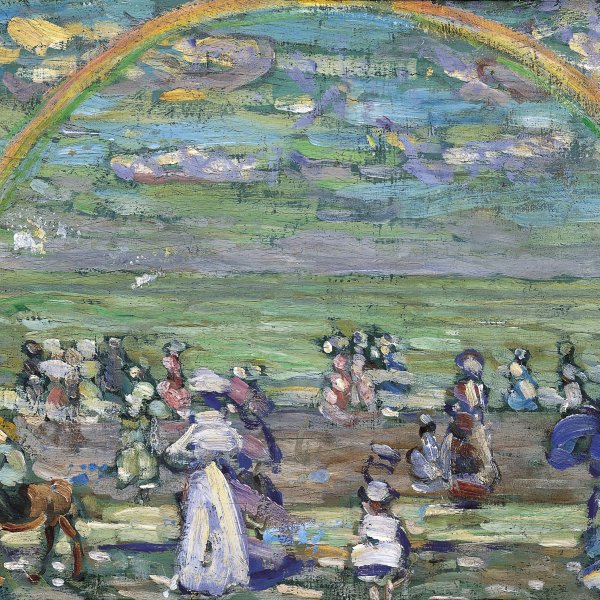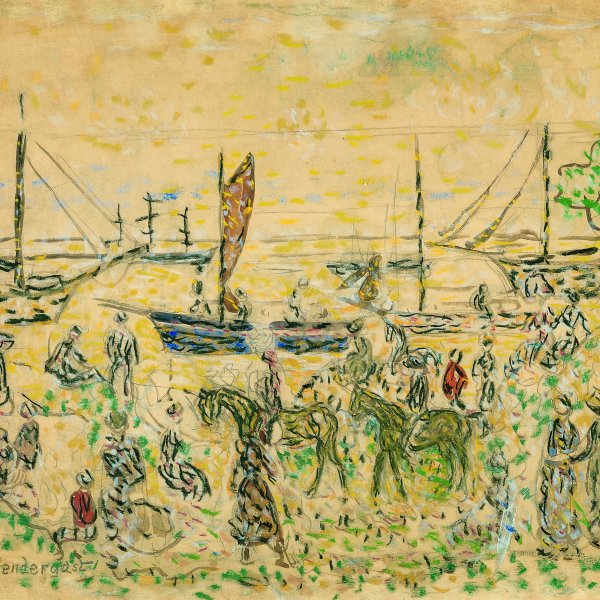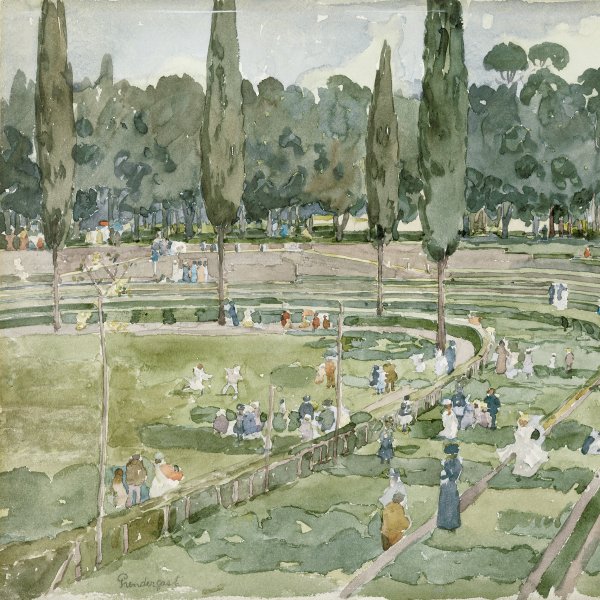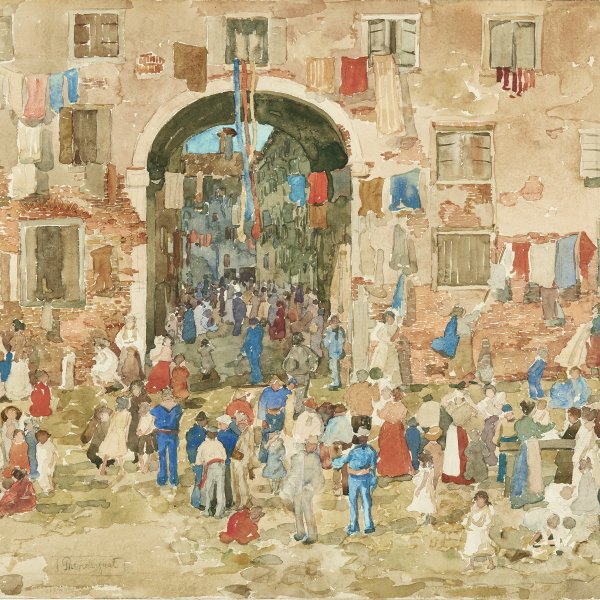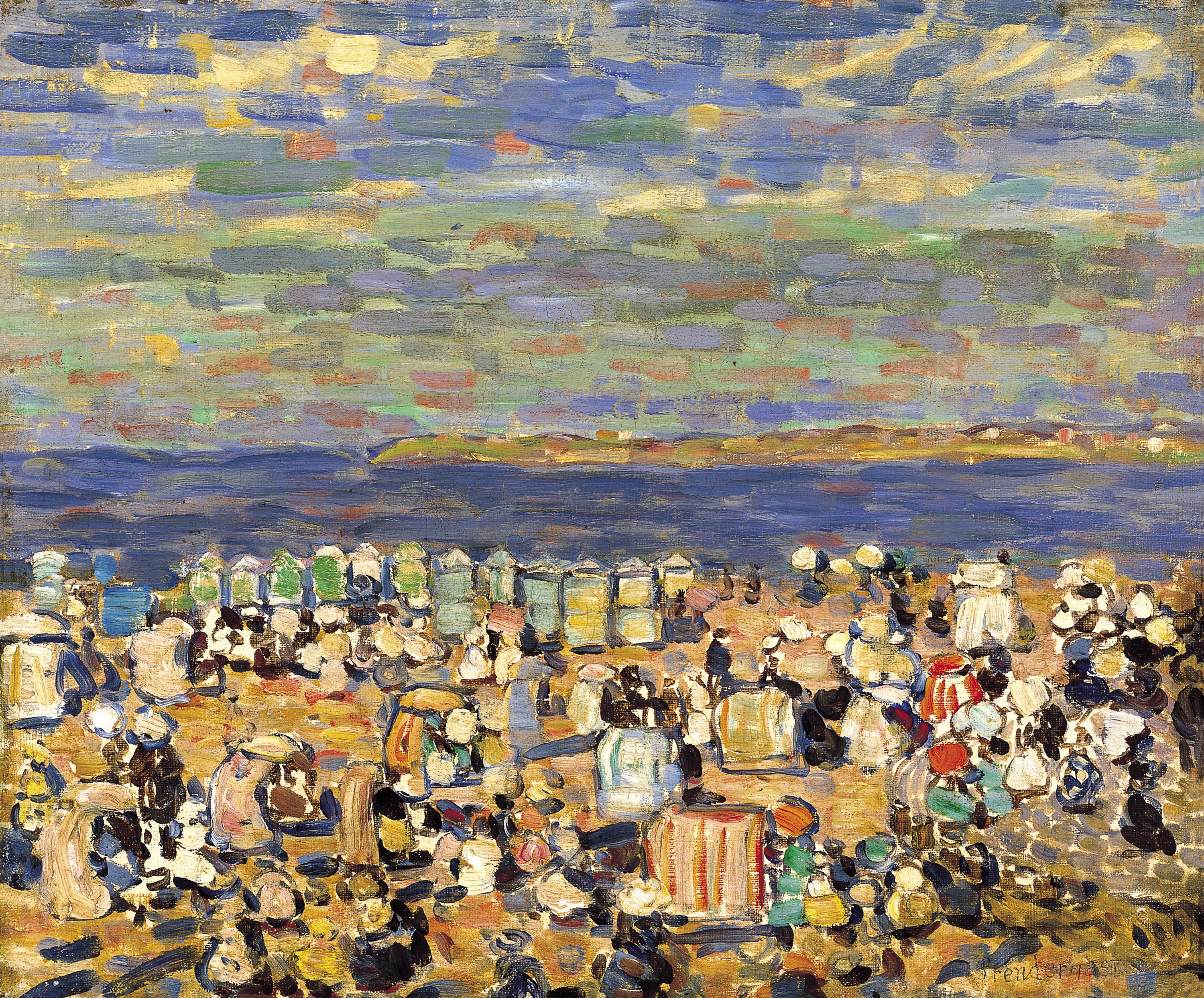Beach at St. Malo
ca. 1907
Oil on canvas.
36.8 x 44.5 cm
Carmen Thyssen Collection
Inv. no. (
CTB.1982.37
)
Room E
Level 0
Carmen Thyssen Collection and Temporary exhibition rooms
Prendergast, who enjoyed swimming, depicted the seashore in countless paintings from Revere Beach or Gloucester in Massachusetts to St. Malo in France. Prendergast loved the sea, and at times, as he was attempting a water cure to alleviate his deafness, his pleasure in bathing took on an almost hedonistic quality. "To take off one's clothes and lay full stretched on the sand exposed to the wind and the sun is the finest sensation I know on a spring day. Even in cold days in March one little realizes the penetrating force of the sun on the body."
Although Prendergast had visited St. Malo during his 1891-1894 stay in Paris and also in 1914, it was his two-month summer visit in 1907 that inspired most of his canvases. St. Malo, situated on the Brittany Coast, had at the time a little more than ten thousand inhabitants. Prendergast was obviously attracted by the coastal town with "its high tides and ramparts, " where he painted such landmarks as the lighthouse and Chateaubriand's Tomb, but it was the fine sandy beach with its colourful bathing tents that attracted him the most. As with the artist's earlier paintings of Revere Beach, he has assumed an elevated viewpoint looking down to the bathers on the warm sands of the resort town.
Prendergast's paintings of St. Malo followed his exposure in Paris to the work of the French modernists whose intense colours had made a great impression on the artist. "All those exhibitions worked me up so much, " he wrote, "that I had to run up and down the Boulevards to work off stream." There is a noticeable heightening of colour and a discernable movement towards abstraction in his works of St. Malo which were either painted on the site or shortly after his return home. In Beach at St. Malo the rectangular play of the bathing tents are contrasted to the rounded forms of the figures, reduced far more than usual for Prendergast to geometric shapes. The warm verticals of bathers and tents are opposed to sea and sky composed of cool horizontal strokes of colour interspersed with warmer tones.
Beach at St. Malo was probably one of the two paintings entitled Beach, St. Malo which were exhibited at the exhibition of The Eight at Macbeth's Gallery in 1908. Of the seventeen works the artist exhibited, at least eleven were scenes of St. Malo. As the most radical member of the group, Prendergast received the greatest critical abuse. Arthur Hoeber, critic for the Globe, sarcastically wrote that "Maurice Prendergast sends nearly a score of modest sized canvases, full of spots of colour, with many people mainly on the beach at the French St. Malo, obviously a place where the sun shines in a curious manner, where colour is wonderfully made manifest, where the people are careless about their drawing and construction, and where everything is a jumble of riotous pigment, such as one does not see elsewhere. Hung as a group, these canvases of Mr. Prendergast look for all the world like an explosion in a colour factory." Hoeber's attack reflects both Ruskin's diatribe against Whistler for "flinging a pot of paint in the public's face, " as well as anticipating the criticism of Marcel Duchamp's Nude Descending the Staircase, No. 2, exhibited in the 1913 Armory Show, which was characterised as "an explosion in a shingle factory." Another critic dismissed Prendergast's works as being "the product of the cider much drunk at St. Malo in Brittany, [...] blotches of paint on canvas without harmony of color or tone."
Beach at St. Malo has previously been dated 1909. Prendergast's works of St. Malo done during this period, including watercolours inscribed 1909, have now been assigned a date of c. 1907 in the 1990 catalogue raisonné of the artist's work.
Kenneth W. Maddox
Although Prendergast had visited St. Malo during his 1891-1894 stay in Paris and also in 1914, it was his two-month summer visit in 1907 that inspired most of his canvases. St. Malo, situated on the Brittany Coast, had at the time a little more than ten thousand inhabitants. Prendergast was obviously attracted by the coastal town with "its high tides and ramparts, " where he painted such landmarks as the lighthouse and Chateaubriand's Tomb, but it was the fine sandy beach with its colourful bathing tents that attracted him the most. As with the artist's earlier paintings of Revere Beach, he has assumed an elevated viewpoint looking down to the bathers on the warm sands of the resort town.
Prendergast's paintings of St. Malo followed his exposure in Paris to the work of the French modernists whose intense colours had made a great impression on the artist. "All those exhibitions worked me up so much, " he wrote, "that I had to run up and down the Boulevards to work off stream." There is a noticeable heightening of colour and a discernable movement towards abstraction in his works of St. Malo which were either painted on the site or shortly after his return home. In Beach at St. Malo the rectangular play of the bathing tents are contrasted to the rounded forms of the figures, reduced far more than usual for Prendergast to geometric shapes. The warm verticals of bathers and tents are opposed to sea and sky composed of cool horizontal strokes of colour interspersed with warmer tones.
Beach at St. Malo was probably one of the two paintings entitled Beach, St. Malo which were exhibited at the exhibition of The Eight at Macbeth's Gallery in 1908. Of the seventeen works the artist exhibited, at least eleven were scenes of St. Malo. As the most radical member of the group, Prendergast received the greatest critical abuse. Arthur Hoeber, critic for the Globe, sarcastically wrote that "Maurice Prendergast sends nearly a score of modest sized canvases, full of spots of colour, with many people mainly on the beach at the French St. Malo, obviously a place where the sun shines in a curious manner, where colour is wonderfully made manifest, where the people are careless about their drawing and construction, and where everything is a jumble of riotous pigment, such as one does not see elsewhere. Hung as a group, these canvases of Mr. Prendergast look for all the world like an explosion in a colour factory." Hoeber's attack reflects both Ruskin's diatribe against Whistler for "flinging a pot of paint in the public's face, " as well as anticipating the criticism of Marcel Duchamp's Nude Descending the Staircase, No. 2, exhibited in the 1913 Armory Show, which was characterised as "an explosion in a shingle factory." Another critic dismissed Prendergast's works as being "the product of the cider much drunk at St. Malo in Brittany, [...] blotches of paint on canvas without harmony of color or tone."
Beach at St. Malo has previously been dated 1909. Prendergast's works of St. Malo done during this period, including watercolours inscribed 1909, have now been assigned a date of c. 1907 in the 1990 catalogue raisonné of the artist's work.
Kenneth W. Maddox





